Slack is a great communication tool for desk-based collaboration, whereas Connecteam is an all-in-one, mobile-first platform built for the specific needs of deskless teams, going far beyond communication alone.
Managing a workforce without the right communication tools can lead to all sorts of work chaos. Connecteam and Slack are 2 popular software solutions to address this challenge, but they focus on different audiences. So, how can you tell which is right for you?
Below, I compare them in depth to help you decide which tool will truly connect your workforce.
A note about our method: All product comparisons and verdicts in this guide are based on hands-on testing by our expert team. Every screenshot was taken from real use during our evaluation.
At a Glance: Quick Summary
Connecteam is known for its all-in-one, mobile-first design that makes it ideal for businesses with deskless and field-based employees. It combines communication, time tracking, scheduling, task management, and HR into a single, easy-to-use application.
Slack has a strong reputation as a world-class communication hub. It’s especially useful for desk-based knowledge workers and tech companies. These organizations need to integrate dozens of other software tools into a central conversation platform.
The Everything Your Team Needs App
Connecteam is more than just a chat app, with scheduling, tasks, HR, and more all in one place.
Pricing and Plans
Slack uses a per-user, per-month fee.
In contrast, Connecteam uses a flat-fee model with per-user costs after the first 30 users. This is much more predictable and scalable for businesses that employ a large number of hourly or part-time workers.
| Plan Type | Connecteam | Slack |
| Free | Small Business Up to 10 users Includes full access to all features, such as team chat, updates with likes and comments, scheduling, and forms | Free Unlimited users Limited to 90-day message history and 10 app integrations Video/audio calls (Huddles) are 1:1 only |
| Starter | Basic $29/month for the first 30 users Adds the ability to include media and file attachments in updates and view post insights | Pro $7.25/user/month Unlocks unlimited message history and unlimited integrations Group Huddles are expanded to include up to 50 people |
| Business | Advanced $49/month for the first 30 users Adds features like scheduled messages, live poll posts, and anonymous surveys | Business+ $15/user/month Includes all Pro features, plus AI-powered search and file summaries. |
| Premium | Expert $90/month for the first 30 users Adds features like scheduled feed updates, shortcuts, and auto-translate | N/A |
| Enterprise | Enterprise Custom pricing Adds features including single sign-on (SSO) and biometric app lock, as well as a customer success manager | Enterprise+ Plan Adds features like data loss prevention to scan messages for sensitive information |
| * All prices show the monthly cost when billed annually as of August 2025. | ||
While both platforms offer a free plan, Slack’s free plan has a 90-day message history limit. Any conversation or file older than 90 days becomes inaccessible. This means Slack’s free plan is unusable for tracking project history or compliance.
Connecteam offers an industry-leading free option with its Small Business Plan. You get full access to all its features for up to 10 users, completely free, forever. I think this is an extremely strong cost proposition. For larger teams, its paid plans start with a flat monthly fee for the first 30 users.
Even when you add more users, the additional cost is just $0.50-$3.00/month/user, which is much more cost-effective than Slack. This model prevents costs from spiraling as you add seasonal or part-time staff, too. Any way you look at it, Connecteam is much better value than Slack for deskless businesses.
Pros and Cons
Every platform has strengths and weaknesses. Here’s what I think are the most important things to consider about Connecteam and Slack.
Connecteam pros ✅
- Built for deskless communication: From its mobile-first UI to its feature set, it’s made for on-the-go communication needs.
- Trackable and secure: Read receipts on announcements and admin controls over chat provide great oversight for managers. They ensure important information gets delivered and acknowledged, which is essential for compliance.
- All-in-one simplicity: Communication tools are built into work features like scheduling and task management for a single, unified workflow that reduces the need for multiple apps.
Connecteam cons ❌
- No native video calling: While you can attach videos to chats, the platform lacks a built-in feature for live voice and video calls. This is a notable gap for teams that must switch between text and real-time meetings.
- Learning curve for advanced features: While the app is designed to be intuitive for employees, it takes a little time to master the full suite of administrative features and customizations.
Slack pros ✅
- Exceptional communication features: Slack offers a best-in-class experience for real-time messaging, multi-user conversations, and organized channels. I feel it’s well-designed for complex, desk-based collaboration.
- Market dominance: Since it’s one of the most popular communication tools out there, new team members often don’t need much training, and they can easily find help from online tutorials.
- Powerful voice and video tools: Native audio and video “Huddles” allow for spontaneous, drop-in conversations. These replicate the feel of an in-person office.
Slack cons ❌
- Not built for deskless work communication: Slack completely lacks built-in features for shift scheduling, employee time tracking, or digital checklists, really limiting its usefulness for full team management and forcing you to rely on costly third-party integrations.
- High total cost of ownership (TCO): The per-user pricing, combined with the need to pay for multiple additional apps to get basic operational functionality, makes Slack very costly for managing deskless teams.
Use Cases
Whether Slack or Connecteam will work for you mostly comes down to the kind of work your team does.
Connecteam is best for:
- Field communication and coordination. Connecteam is designed for environments like construction or field services where sending a safety update with read receipts is essential for compliance. Sharing a photo of a site issue is more effective than a long text conversation.
- Shift handoffs and retail updates. In healthcare or retail, managers can attach specific instructions to an incoming shift. They can use the “Updates” feed to ensure all stores receive the same promotion information at the same time.
- Mobile workforce management. Beyond communication, it’s fantastic for managing teams in the field. I love the GPS time clock for accurate location tracking, and employees can conveniently chat, check their schedules, and more from the mobile app.
Slack is best for:
- Collaboration for knowledge workers. Its powerful channels and threads are perfect for software developers, marketing teams, and other desk-based professionals. These workers must collaborate on complex projects without constant meetings.
- Centralizing notifications from other software. Slack can work well as a “digital headquarters” that pulls in alerts and updates from dozens of other systems like Salesforce, Google Drive, and Asana, keeping everyone in the loop.
Side-by-Side Feature Overview
To dig deeper into this comparison, I’ve thought about the main features I care about when communicating with a deskless team. I’ve declared a winner for each category based on hands-on testing and research.
Team chat and messaging – Winner: tie
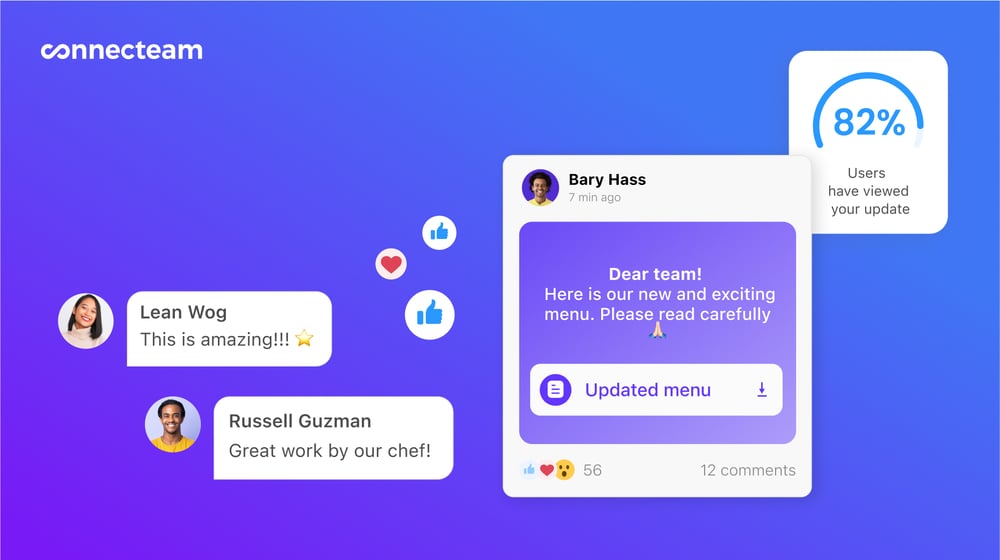
Connecteam’s online team chat is designed for secure, task-focused communication. It supports file sharing, images, videos, and location sharing. Users can communicate with each other or in groups, and chats can be organized around departments, projects, jobs, chats, and more.
A key feature is Shortcuts. Users can link directly to other parts of the app (like a specific form or training course) from within a chat message. For employees, this makes communication feel actionable and directly tied to their work. For managers, the strengths are in security and oversight. Admins can monitor conversations and prevent media from being saved to personal devices.
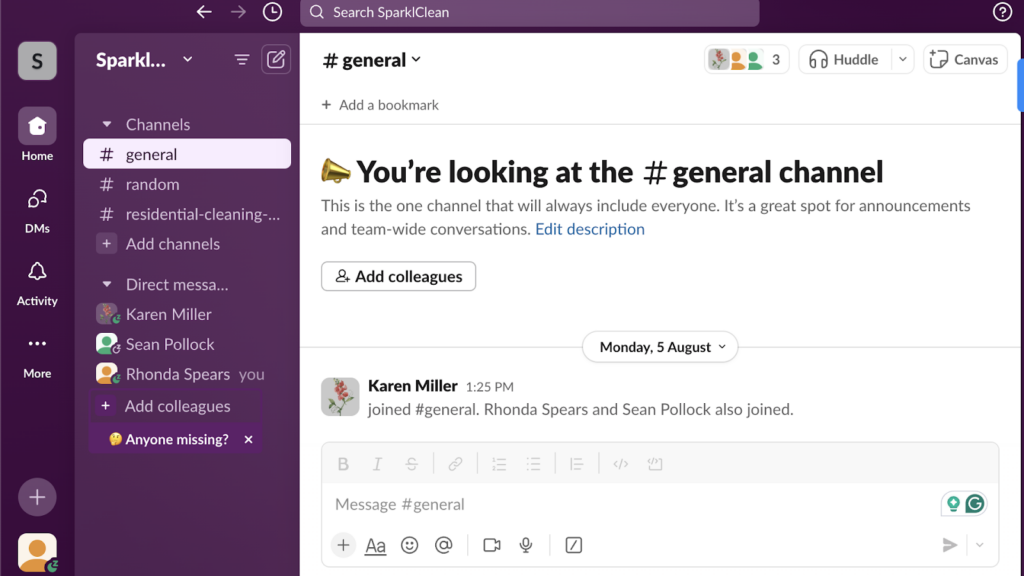
Slack’s chat is built around channels and direct messages. It’s designed for rich, detailed conversations. Its strengths lie in features like message threading (which allows for focused side-conversations), advanced message formatting, and a vast emoji library. We really appreciated all these features when we tested it.
With Slack, knowledge workers get a more expressive and organized conversational space. File sharing is deeply integrated with tools like Google Drive, too, making collaboration on documents directly within the conversation simple.
The winner depends on your goal:
- Connecteam for controlled, trackable, and task-driven chat
- Slack for rich, expressive, and project-driven collaboration.
Company announcements and updates – Winner: Connecteam
Connecteam’s employee updates feature is its great tool for top-down communication. It works like a private, internal social media-style feed. Managers can see exactly who has read a message and when. They can even send automated reminders to those who haven’t seen a message, so no important information is ever missed.
Slack handles announcements through dedicated, permissions-restricted channels (e.g., #announcements). While I think this is relatively effective for distributing information, Slack doesn’t have a native read-receipt function. This means employees could miss important updates, and you wouldn’t know.
For businesses where verifying message delivery is a matter of compliance or safety, Connecteam’s trackable delivery system is superior.
Make Sure Every Message is Seen
Connecteam lets you track read receipts and send reminders so nothing important gets missed.
Video and audio calling – winner: Slack
Slack’s Huddles are a core part of its functionality. With a single click, users can start an informal audio or video call with screen sharing directly from any channel or direct message. Paid plans support group calls with up to 50 people. This is perfectly suited for the needs of remote and hybrid teams who need spontaneous collaboration.
When we tested Slack, our tester loved how users can get into a huddle with just a click, which she believes can give these meetings the “feel of a quick office chat.”
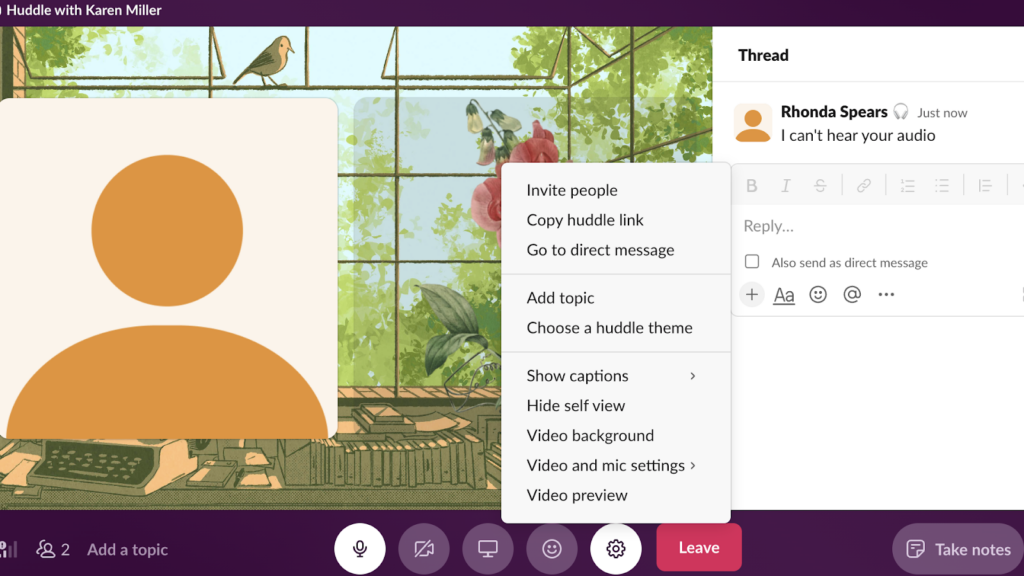
Connecteam lacks a native voice or video calling feature. Instead, users can record and share video messages and voice clips directly in any chat. This model is designed for deskless teams where an immediate, live conversation isn’t always practical, but sending a quick verbal update or a visual report is highly effective.
For any team that needs to smoothly switch between written and verbal communication, Slack is the better choice.
Surveys, polls, and feedback – Winner: Connecteam
Connecteam includes native tools for creating employee communication surveys and live polls. It supports various question types and, importantly, offers an anonymity option. I love this because I think it helps employees feel safer to express honest feedback. Live polls can be embedded directly into the Updates feed, driving high engagement.
Slack relies on its app marketplace for sophisticated polling and surveys. While basic polls can be created with emoji reactions, any advanced functionality requires installing and potentially paying for a third-party app like Polly or Simple Poll.
For organizations that want a simple, built-in way to gather feedback, I think Connecteam’s native tools are more efficient.
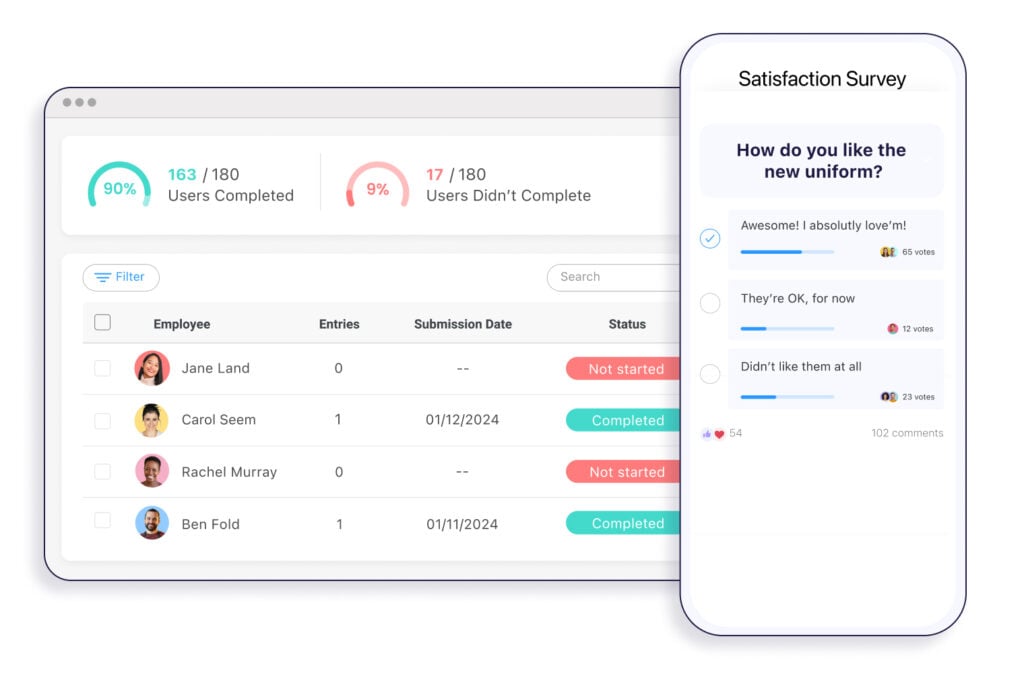
Gather Feedback in Real-Time
Check in with your team with Connecteam’s built-in surveys and live polls.
Employee directory and knowledge base – Winner: tie
Connecteam functions as a classic, top-down employee directory app that’s searchable and contains contact info. From an employee’s perspective, this is a straightforward way to call or email a colleague with a single tap. Managers can also add other work contacts, like suppliers, vendors, or clients. I like how this centralizes all points of contact.
In addition, the employee knowledge management system can be an easy-to-browse repository of important documents like employee handbooks and safety protocols.
Slack’s strength is its powerful universal search. This indexes every message and file, turning the entire platform into a deep, searchable knowledge repository.
Instead of a static knowledge base, it offers Canvases. These are flexible documents that live within channels and can be updated by the team. When we tested them, we liked how they enabled quick, fuss-free collaboration. This is better for “living” documents and project plans.
Users can also search directly for other users’ profiles or specific user groups (such as specific project teams). A formal employee directory (Slack Atlas) is only available as a paid add-on.
The best tool depends on the type of information:
- Connecteam for a structured directory and static resources.
- Slack for a dynamic, searchable archive of people, conversations, and collaborative documents.
Admin controls – Winner: tie
Both platforms offer strong controls. But they’re tailored for different priorities.
Connecteam’s controls are focused on oversight and data security for a mobile workforce. Admins can moderate chats, prevent messages from being forwarded, and ensure media isn’t saved to personal devices. You can also lock chats, delete messages, and enable only certain users to initiate chats.
You can also easily make the chat HIPAA compliant (more on this below).
Admins can do many of the same things on Slack: They can limit who creates channels, archive or delete messages, and set retention rules for conversations. Slack also provides enterprise-grade controls on its higher-tier plans. These include custom data retention policies, eDiscovery exports, and integration with Data Loss Prevention (DLP) tools.
But unfortunately, Slack can be configured for HIPAA compliance only with its top-tier Enterprise+ plan. This puts it out of reach for smaller organizations.
For smaller businesses, especially in healthcare, Connecteam’s accessible compliance is a major advantage. For large enterprises with complex needs, Slack’s enterprise-level controls are more powerful.
Additional features – Winner: Connecteam
Both platforms have some stellar additional features.
Slack’s additional features include Slack Connect, which lets you collaborate with external organizations through the platform. There are also automations, including a workflow builder that helps you create custom processes (like sending automatic reminders).
We think its AI features give it an edge over many dedicated communication platforms. Its AI can summarize messages and files, translate, assist users, and more.
Connecteam’s additional communication features include an internal ticketing feature, which lets employees submit questions or requests to designated reps, plus an event app, which makes it easy to coordinate company events.
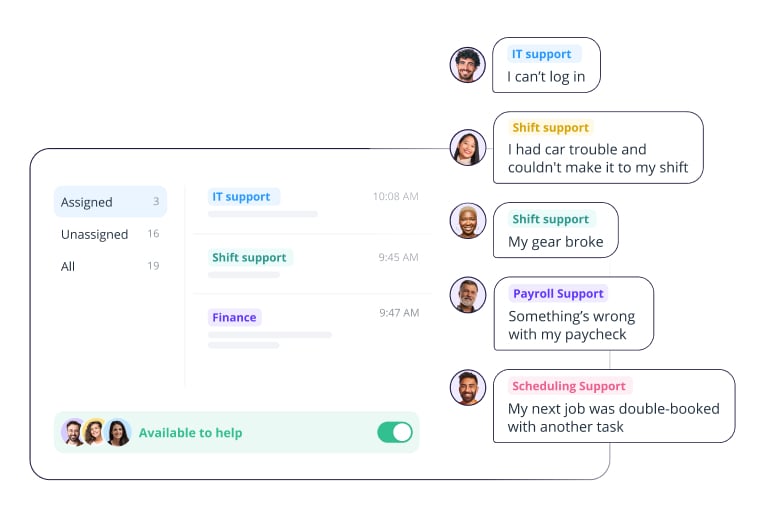
I think Connecteam’s core value is its all-in-one design. Unlike Slack, which requires third-party integrations for non-communication work functions, Connecteam includes them natively. It has tools for time tracking, scheduling, task management, digital forms, HR, onboarding, and more.
If you’re looking for an affordable all-in-one app, Connecteam is the winner. (That said, for those fine with using various platforms, Slack integrates with tons of other tools…but costs add up quickly.)
User Ratings
Connecteam consistently earns high marks on mobile app stores and is praised for its customer support. Slack is rated highly for its desktop experience but receives lower scores for its mobile apps.
Connecteam
Slack
Security & Compliance
Both platforms offer features like data encryption and two-factor authentication. However, there is an important difference in HIPAA compliance. Connecteam offers HIPAA compliance as a standard feature. By signing a Business Associate Agreement (BAA), organizations can enable a HIPAA-compliant chat. Connecteam understands its importance to industries like home care.
Slack, in contrast, only makes HIPAA compliance possible on its most expensive Enterprise+ plan. Even then, it can require the company to integrate and manage separate, third-party Data Loss Prevention (DLP) and archival tools. This makes Slack’s path to compliance expensive and complex for the vast majority of healthcare organizations.
| Category | Connecteam | Slack |
| Data Encryption | ✅ | ✅ |
| GDPR Compliant | ✅ | ✅ |
| HIPAA Compliant | ✅ Available on all plans | ⚠️ Only on the Enterprise+ plan, often requires third-party tools |
| Two-Factor Authentication | ✅ Yes | ✅ Yes |
| SOC 2 Certified | ✅ Yes | ✅ Yes |
Setup and Onboarding
The setup process for each platform is tailored to its target user.
For Connecteam, the implementation is designed to be fast and simple for business managers. When I tested the process, I found I could get a new account running and start adding employees within a few hours. The employee onboarding is exceptionally easy, too: You just need a name and a mobile number. The employee gets a text with a link to download the app and log in.
When we tested Slack’s basic functionality, our tester created an account, added profile and team details, and sent invites in under 2 minutes. But unfortunately, one invite went to an employee’s junk folder. In a real-world scenario, that employee might miss out on the invite.
For larger organizations, a Slack deployment is typically more like an IT project. It involves an administrator creating a workspace, designing a channel structure, researching and integrating third-party apps, and then formally training the team. I think this structured process is fine for a corporate setting but overly complex for a small business owner who just needs to get their team coordinated.
Support and Customer Service
Often overlooked until it’s too late, excellent customer support is really important when a platform is the core of your daily operations. This is an area where I found a major difference. Connecteam consistently earns outstanding praise for its customer service, whereas Slack is a mixed bag.
| Support Type | Connecteam | Slack |
| 24/7 Chat | ✅ | ⚠️ Only on Business+ and Enterprise plans |
| Phone Support | ❌ | ❌ |
| Email Support | ✅ | ✅ |
| Help Center | ✅ | ✅ |
Connecteam provides 24/7 live support with a stated response time of under 5 minutes. This is remarkable and a huge asset for managers who run into issues in the middle of a busy day. User reviews on G2 frequently describe the team as “amazing“, “friendly“, and “efficient“. There’s even the option of Connecteam Pros, a paid certified partner service where an expert will act as your onboarding manager, learning your business processes and setting up Connecteam systems for you.
Slack’s support is tiered by plan. While users of the paid Pro plan get priority support, only Business+ and Enterprise Grid customers get 24/7 access with a guaranteed 4-hour response time. When we submitted a support request on the Pro trial, the response was fast and helpful.
However, the level of accessibility and the user praise for Connecteam’s support give it an edge. This is especially true for businesses without an internal IT helpdesk.
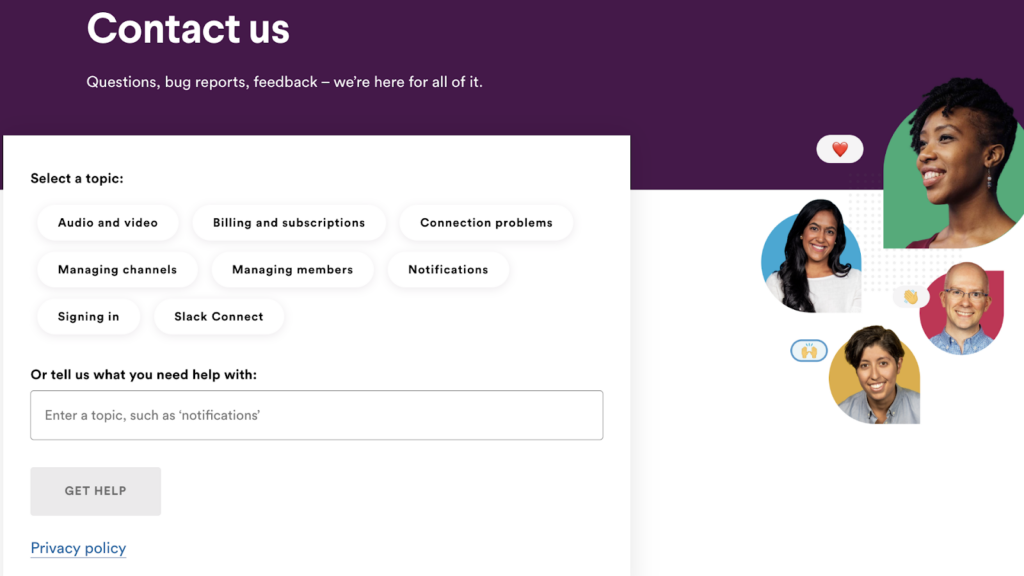
To put a number on it, G2 user reviews rate Connecteam’s support quality at a remarkable 9.2/10, compared with Slack’s 8.8/10. Users also give Connecteam a very high score (9.6) for “product direction,” which shows the company is actively listening and evolving the platform to meet its customers’ real-world needs.
🏆 Who Wins: Connecteam or Slack?
After a thorough review, the choice depends entirely on your team’s communication needs and work environment.
| Choose Connecteam if… | Choose Slack if… |
| Your priority is ensuring every employee receives and acknowledges important information like safety protocols, schedules, and policy updates. | Your priority is creating real-time, agile discussion, brainstorming, and knowledge sharing among project teams. |
| Your team is deskless and needs to communicate quickly on the go. They often link messages directly to tasks, forms, or locations. | Your team works at a computer and needs a persistent digital space for deep, multi-threaded conversations and collaboration on digital assets. |
| You operate in a regulated industry and need proof of message delivery (read receipts) and HIPAA compliance. | You rely on a wide range of software (Jira, Salesforce, etc.) and need a central hub to consolidate notifications and workflows. |
| You have a large number of part-time or hourly employees and need a predictable, flat-fee pricing model that won’t spiral. | Your budget can accommodate a per-user cost, and you need advanced features like Huddles and a vast app ecosystem for every user. |
| Learn more about Connecteam’s communication hub | Read our in-depth Slack review |
Our take
Slack is a popular communication tool for a reason. It’s excellent at what it was designed to do: facilitate complex communication for office-based teams. But for businesses that manage deskless workforces, its lack of native operational features can mean that you end up with a system that is expensive, complicated, and inefficient.
Connecteam is the smart choice for any employer managing deskless teams. Its platform is purpose-built to solve the real-world operational challenges of industries like construction, healthcare, retail, and field services. It integrates secure, trackable communication with the work tools that run the business (scheduling, tasks, forms), making it a single, cost-effective, and easy-to-use solution that empowers both managers and their frontline employees.
FAQs
Does Connecteam integrate with Slack?
Yes, Connecteam can be integrated with Slack through an automation platform like Zapier. This allows you to do things like send a notification to a Slack channel when a form is submitted in Connecteam.
Is Slack truly free?
Slack has a free plan, but it has limitations for business use. For instance, it stores your message and file history for only 90 days. After that, the information is gone unless you upgrade to a paid plan.
Is Connecteam’s chat HIPAA compliant?
Connecteam can be configured for HIPAA compliance by signing a Business Associate Agreement (BAA). This makes its secure chat suitable for communicating protected health information (PHI).
Is Slack suitable for managing tasks?
Slack has some very basic task management features like reminders and simple lists. However, for any kind of structured operational task like a safety checklist or an inspection report, it’s not suitable and requires integration with a third-party application.

